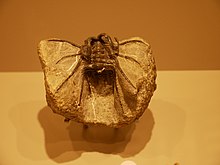| Dicranurus Temporal range:
| |
|---|---|

| |
| Dicranurus hamatus elegantus | |
| Scientific classification | |
| Kingdom: | |
| Phylum: | |
| Class: | |
| Order: | Moore, 1959
|
| Family: | |
| Genus: | Dicranurus
|
| species | |
| |

Dicranurus (Greek, 'dikranon', a pitchfork, and 'oura', tail) is a genus of Lower to Middle Devonian odontopleurid trilobites that lived in a shallow sea that lay between Euramerica and Gondwana, corresponding to modern-day Oklahoma and New York, and Morocco, respectively. As such, their fossils are found in New York, Oklahoma, and Morocco. Their bodies averaged about 1-inch (25 mm) or so, in length, though their large spines made them at least 2 inches (51 mm) in length. It is speculated that such tremendous spines hampered the ability of predators, such as arthrodire placoderms, to attack them, as well as to help prevent them from sinking into the soft mud of their environment. Dicranurus trilobites are distinguished from other odontopleurids by the pair of large, curled, horn-like spines that emanate from behind the glabellum. The genus name refers to these distinctive horns, in fact.